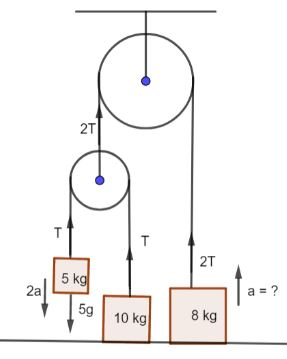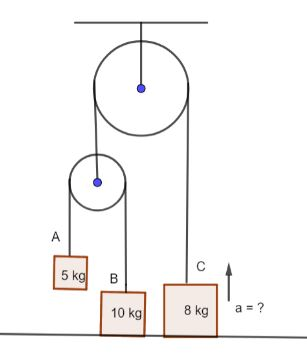Answer
318k+ views
Hint: In this question, we will first draw all the forces-tension in the strings and weight of the blocks- and equate all the vertical force for a particular block to obtain two equations. Here, since block B is grounded, the acceleration will be imparted completely from block A. Hence, the acceleration of block A will be twice the acceleration of block C. On solving the two equations, we shall calculate the value of the acceleration of block C.
Complete step by step answer:
Let’s visualize the situation first.

In the figure all the forces have been marked accordingly.Since nothing has been mentioned about the pulley in terms of whether they are movable or not, we shall consider them to be fixed. If we consider the string connecting the smaller pulley and the block A, the tension in the string is T.The tension in the string connecting the bigger pulley and the block C is marked 2T because the tension in the string has to remain constant.
For block A, on equating the forces to maintain the vertical equilibrium we get,
$5g - T = 5(2a)$
$ \Rightarrow 5g - T = 10a\,\,\,\,\,\,\,\,\,\,\,.......(1)$
For block C, on equating the forces to maintain the vertical equilibrium we get,
$2T - 8g = 8a$
$ \Rightarrow T - 4g = 4a\,\,\,\,\,\,\,\,\,\,\,\,..........(2)$
Adding (1) and (2), we get
$g = 14a$
This can be rewritten as $a = \dfrac{g}{{14}}$
Taking $g = 10\,m\,{s^{ - 2}}$ and substituting in the above equation, we get,
$a = \dfrac{{10}}{{14}}\,m\,{s^{ - 2}}$
$ \therefore a = \dfrac{5}{7}\,m\,{s^{ - 2}}$
Hence, the acceleration of block C will be $\dfrac{5}{7}\,m\,{s^{ - 2}}$.
Note:Block B is grounded. Hence, we took its acceleration to zero. Also, the pulleys were fixed. Had they been movable, they would have also experienced an acceleration which must be accounted for while calculating the acceleration of block C. Also, the tension remained constant throughout the string because it was given that the string was smooth.
Complete step by step answer:
Let’s visualize the situation first.

In the figure all the forces have been marked accordingly.Since nothing has been mentioned about the pulley in terms of whether they are movable or not, we shall consider them to be fixed. If we consider the string connecting the smaller pulley and the block A, the tension in the string is T.The tension in the string connecting the bigger pulley and the block C is marked 2T because the tension in the string has to remain constant.
For block A, on equating the forces to maintain the vertical equilibrium we get,
$5g - T = 5(2a)$
$ \Rightarrow 5g - T = 10a\,\,\,\,\,\,\,\,\,\,\,.......(1)$
For block C, on equating the forces to maintain the vertical equilibrium we get,
$2T - 8g = 8a$
$ \Rightarrow T - 4g = 4a\,\,\,\,\,\,\,\,\,\,\,\,..........(2)$
Adding (1) and (2), we get
$g = 14a$
This can be rewritten as $a = \dfrac{g}{{14}}$
Taking $g = 10\,m\,{s^{ - 2}}$ and substituting in the above equation, we get,
$a = \dfrac{{10}}{{14}}\,m\,{s^{ - 2}}$
$ \therefore a = \dfrac{5}{7}\,m\,{s^{ - 2}}$
Hence, the acceleration of block C will be $\dfrac{5}{7}\,m\,{s^{ - 2}}$.
Note:Block B is grounded. Hence, we took its acceleration to zero. Also, the pulleys were fixed. Had they been movable, they would have also experienced an acceleration which must be accounted for while calculating the acceleration of block C. Also, the tension remained constant throughout the string because it was given that the string was smooth.
Recently Updated Pages
Why Are Noble Gases NonReactive class 11 chemistry CBSE

Let X and Y be the sets of all positive divisors of class 11 maths CBSE

Let x and y be 2 real numbers which satisfy the equations class 11 maths CBSE

Let x 4log 2sqrt 9k 1 + 7 and y dfrac132log 2sqrt5 class 11 maths CBSE

Let x22ax+b20 and x22bx+a20 be two equations Then the class 11 maths CBSE

Let x1x2xn be in an AP of x1 + x4 + x9 + x11 + x20-class-11-maths-CBSE




